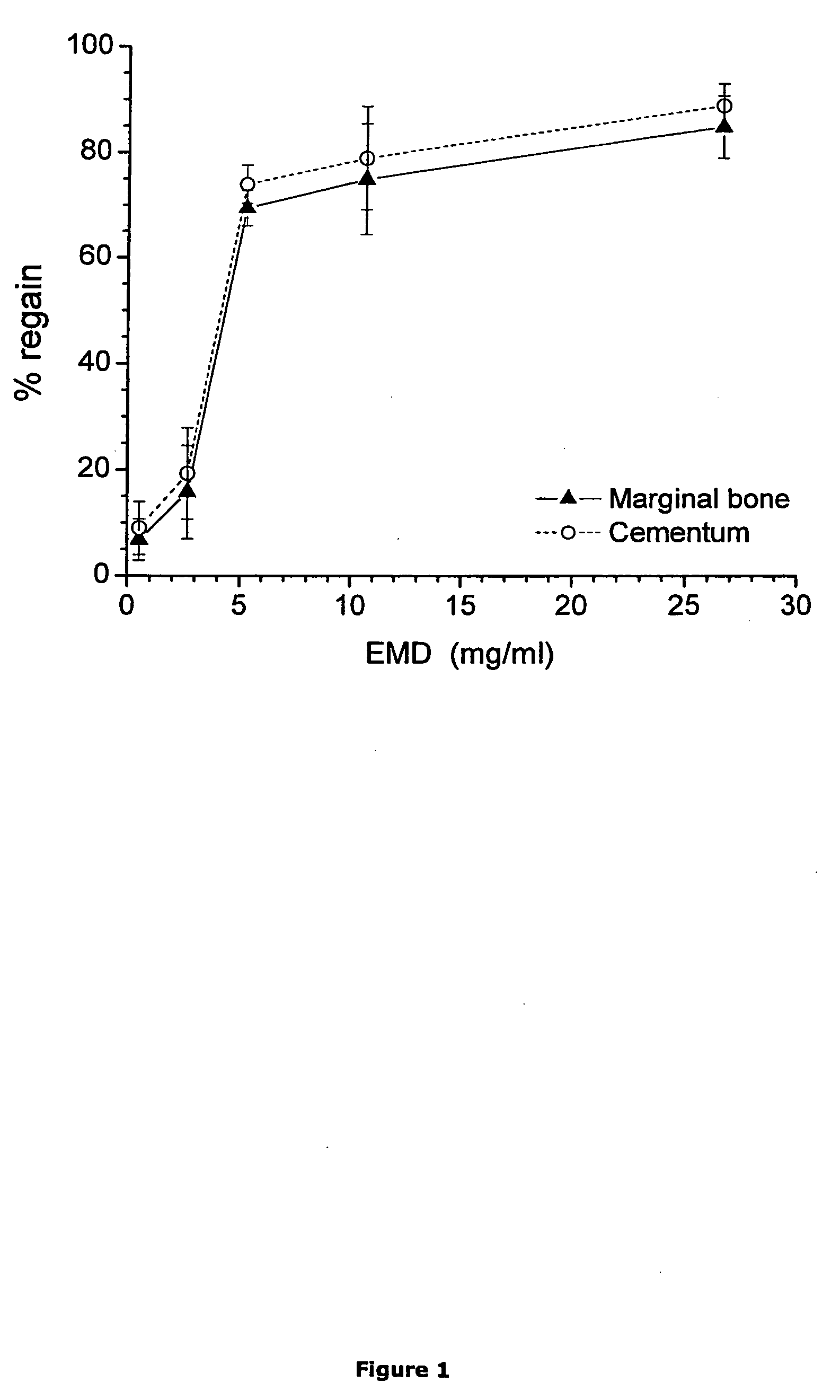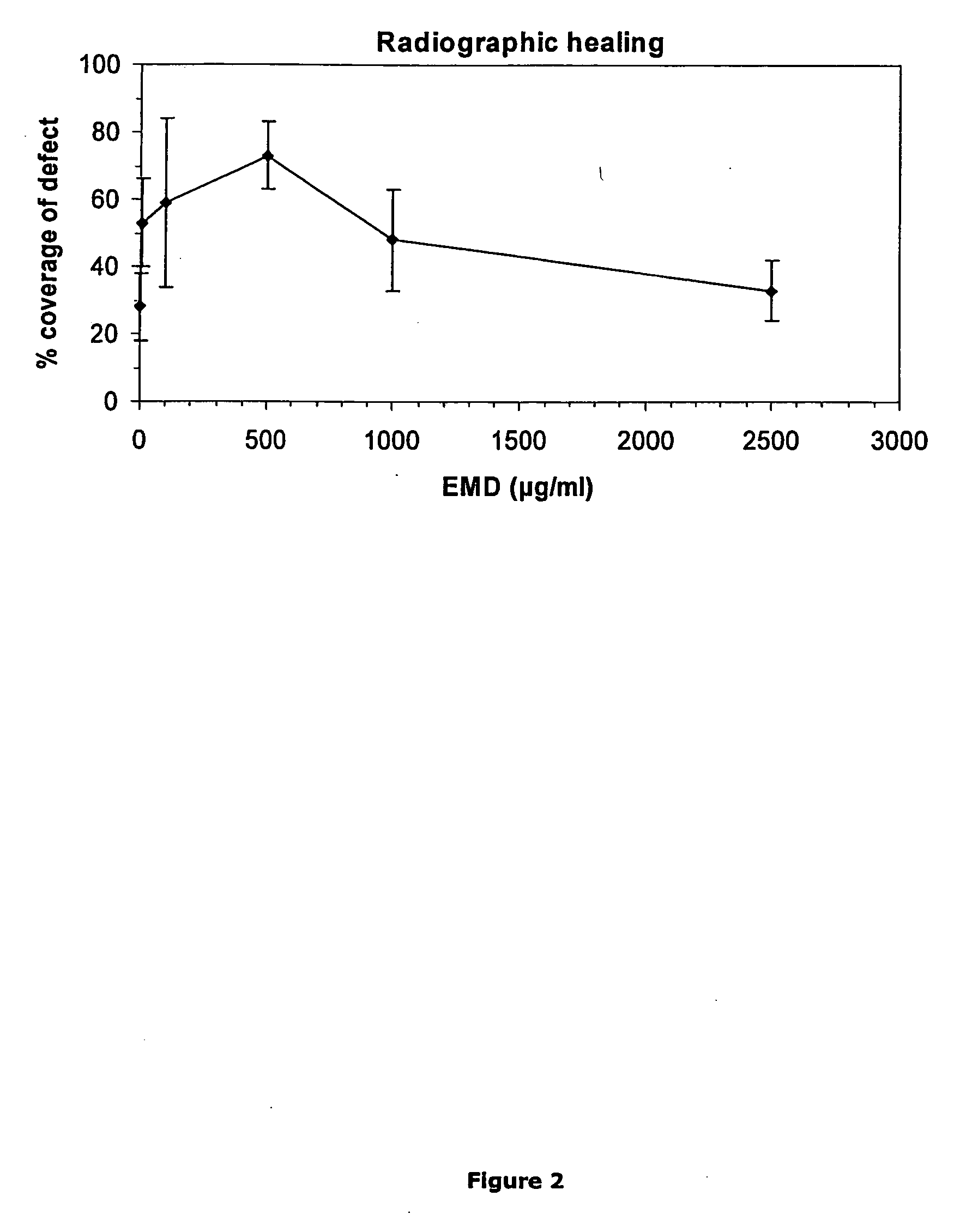Protein formulation
a technology of low concentration and enamel substance, which is applied in the field of new and improved low concentration formulation of enamel substance, can solve the problem that no effect has so far been observed, and achieve the effect of reducing the degradation ra
- Summary
- Abstract
- Description
- Claims
- Application Information
AI Technical Summary
Benefits of technology
Problems solved by technology
Method used
Image
Examples
example 1
[0208] Tooth Supporting Tissue Regeneration in Monkey
[0209] The aim of the present study was to assess the effect of different concentrations of Enamel Matrix Derivative admixed with the vehicle Propylene Glycol Alginate, on regeneration of tooth supporting tissues, as well as to assess Its biological safety. The Enamel Matrix Derivative used herein is made up of the low-molecular weight protein fraction of a standard Enamel Matrix Preparation.
[0210] Materials and Methods
[0211] Test substance: Enamel Matrix Derivative, batch PEU 801. Source; Enamel matrix was isolated from porcine tooth germs, homogenized and the low-molecular weight protein fraction extracted. Vehicle; Propylene Glycol Alginate solution 2,5% w / v, batch PGA 803. Storage of test substance and vehicle; The test substance and the vehicle were stored at −18° C. The bottles containing the substance and vehicle were allowed to equilibrate with room temperature before use.
[0212] Administration of test preparation; The ...
example 2
[0251] Rat Critical Size Cranial Defect
[0252] Rat Cranial Surgery
[0253] This animal experiment protocol has been evaluated and permitted by the Veterinary Authority of the Canton of Zurich according to Swiss Federal law (Nr. 152 / 1997). Sprague-Dawley albino rats are used (84-92 days old, all female). They are housed in groups of four animals or less and kept on a standard diet.
[0254] 27 animals are anesthetized by induction and maintenance with Halothan / O2. The surgical area is clipped and prepared with Betadine for aseptic surgery. A linear incision is made from the nasal bone to the midsagital crest. The soft tissue is reflected and the periosteum is dissected from the site (occipital, frontal, and parietal bones). An 8mm craniotomy defect is created with a trephine in a dental handpiece, carefully avoiding perforation of the dura. The surgical area is then flushed with saline to remove bone debris and a preformed gel is placed within the defect. The soft tissues are then close...
example 3
[0259] Tooth Supporting Tissue Regeneration in Pig
[0260] Aim:
[0261] To use a dehiscence model for clinical, quantitative and histological comparisons of the local effects of treatment with enamel matrix derivatives and / or graft materials, PEG gels and on healing and regenerative processes in the jaw as compared with sham control teeth.
[0262] Animals:
[0263] Minipigs, Sus scrofa, adults (>18 months), females. The animals are acclimatized and observed in the local animal facilities prior to surgery.
[0264] Experimental Description: [0265] 1. The animal is maintained under anesthesia (i.m. Ketalar+i.v. Pentotal and Dormicum). Local anesthesia with Xylocain-adrenalin (Dental). [0266] 2. The animal is inspected [0267] 3. If necessary, the pig is shaved around the mouth and the skin is then rinsed with chlorhexidin® (5 mg / ml in 60% EtOH). The operation area is photographed. [0268] 4. Start in Q1:Iinfiltration anesthesia Is applied in the mucobuccal fold. Injections into the interdental...
PUM
| Property | Measurement | Unit |
|---|---|---|
| Mass | aaaaa | aaaaa |
| Concentration | aaaaa | aaaaa |
| Concentration | aaaaa | aaaaa |
Abstract
Description
Claims
Application Information
 Login to View More
Login to View More - R&D
- Intellectual Property
- Life Sciences
- Materials
- Tech Scout
- Unparalleled Data Quality
- Higher Quality Content
- 60% Fewer Hallucinations
Browse by: Latest US Patents, China's latest patents, Technical Efficacy Thesaurus, Application Domain, Technology Topic, Popular Technical Reports.
© 2025 PatSnap. All rights reserved.Legal|Privacy policy|Modern Slavery Act Transparency Statement|Sitemap|About US| Contact US: help@patsnap.com



